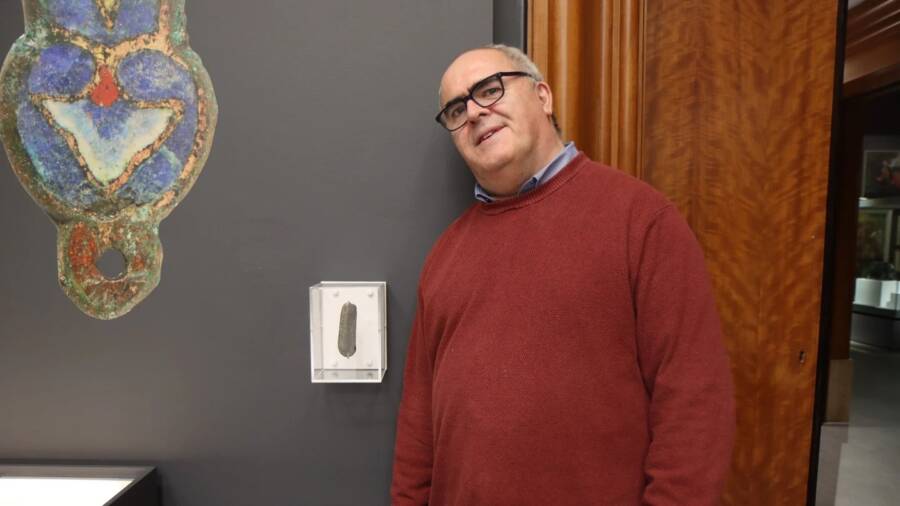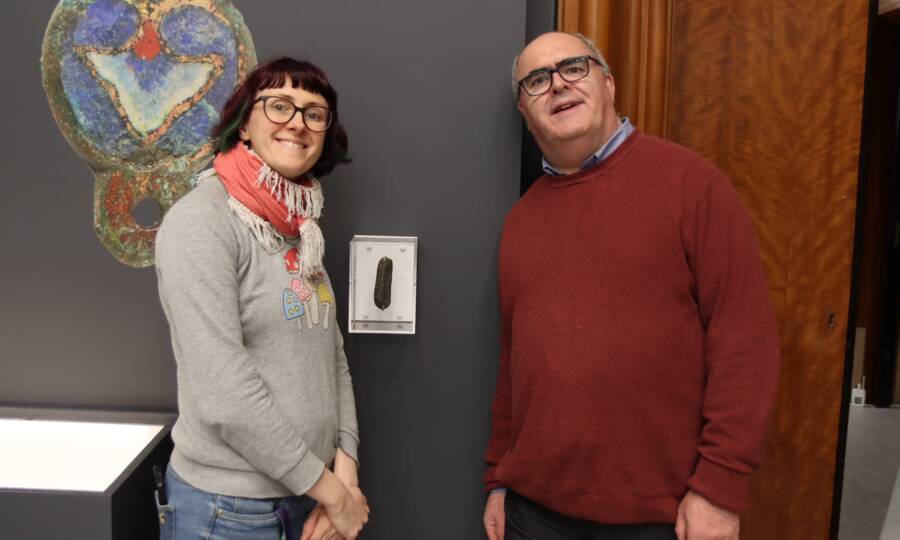Geography teacher Graham Senior came across a stone inscribed with the ancient Irish writing while weeding his garden in Coventry.

The Herbert Art Gallery and MuseumThe Ogham-inscribed stone was found in Graham Senior’s Coventry garden in 2020.
An English geography teacher was tending to his garden in Coventry when he came across one particularly strange rock. Inscribed on its surface were mysterious markings that he did not recognize.
Curious, Graham Senior sent photographs of the rock to a local archaeologist. To Senior’s surprise, the archaeologist revealed that the rock in his garden was inscribed more than 1,600 years ago, and the inscriptions were in Ogham, an early medieval alphabet used for writing in the Irish language.
“I was just clearing a flowerbed of weeds and stones when I saw this thing and thought, that’s not natural, that’s not the scratchings of an animal,” Senior told The Guardian. “It can’t have been more than four or five inches below the surface.”
The Ogham-Inscribed Stone Found In Graham Senior’s Coventry Garden
The rectangular sandstone rock found in Senior’s garden is just over four inches long, weighing roughly five ounces, with inscriptions covering three of its four sides. At first glance, it looks as if something had clawed into it, or perhaps like it had been tally marked. But as Senior soon found out, those lines were actually Ogham letters.
Ogham was an alphabet used primarily to write the Archaic Irish language between the fourth and sixth centuries, and then later employed for writing Old Irish from the sixth to ninth centuries. Ogham was the first written form of the Irish language and examples of it can typically be found on carved stones across Ireland, Wales, and western England. Roughly 400 examples of Archaic Irish Ogham rocks have been discovered thus far, most of which are inscribed with family names to announce land ownership.

The Herbert Art Gallery and MuseumGraham Senior, the teacher who discovered the stone in his garden.
In the world of written language, Ogham is highly unique. Given that it was mostly inscribed onto rocks, it had to be fairly simple and linear. As such, Ogham is written using straight, parallel lines arranged in groups of just one to five.
“It really is quite incredible,” said Ali Wells, a curator at the Herbert Art Gallery and Museum. “The language originates from Ireland. So, to have found it within Coventry has been an exciting mystery. Coventry has been dug up over the years, especially the city center, so there’s not that many new finds.”
The location of the stone is not the only mystery puzzling researchers, though. After decoding its inscription, archaeologists were left wondering what the stone’s purpose had been.
The Mysterious Inscription On The Ogham Stone
Researchers determined that the stone’s inscription reads “Maldumcail/S/ Lass,” but as for what that could mean, they only have theories. Some have suggested that the first bit of the text could be interpreted as a name, MAel Dumcail, but as for what “S” and “Lass” could mean, researchers remain uncertain. One possible theory is that the markings, in some way, point to a specific location.
It is also unclear how the stone ended up in Coventry in the first place.
“These finds do not turn up in the midlands. The bulk of Ogham inscriptions are found over in Ireland,” Teresa Gilmore, the Senior Finds Liaison Officer for the Birmingham Museums Trust, told RTÉ’s Morning Ireland.
“We’re not far from the River Sowe. My thinking is that it must have been a major transport route,” Senior added.

The Herbert Art Gallery and MuseumMuseum curator Ali Wells with Graham Senior.
Ogham was eventually replaced in Ireland by the more common Latin script used throughout much of the Western world. However, the discovery of this Ogham stone in Graham Senior’s garden provides a fascinating insight into the history of the Irish language in the pre-Latin era.
After reading about this historic stone found in a Coventry garden, learn about Ireland’s famous Blarney Stone — and why kissing it has become a tradition. Then, see inside the Book of Kells, Ireland’s stunningly illuminated gospels.





